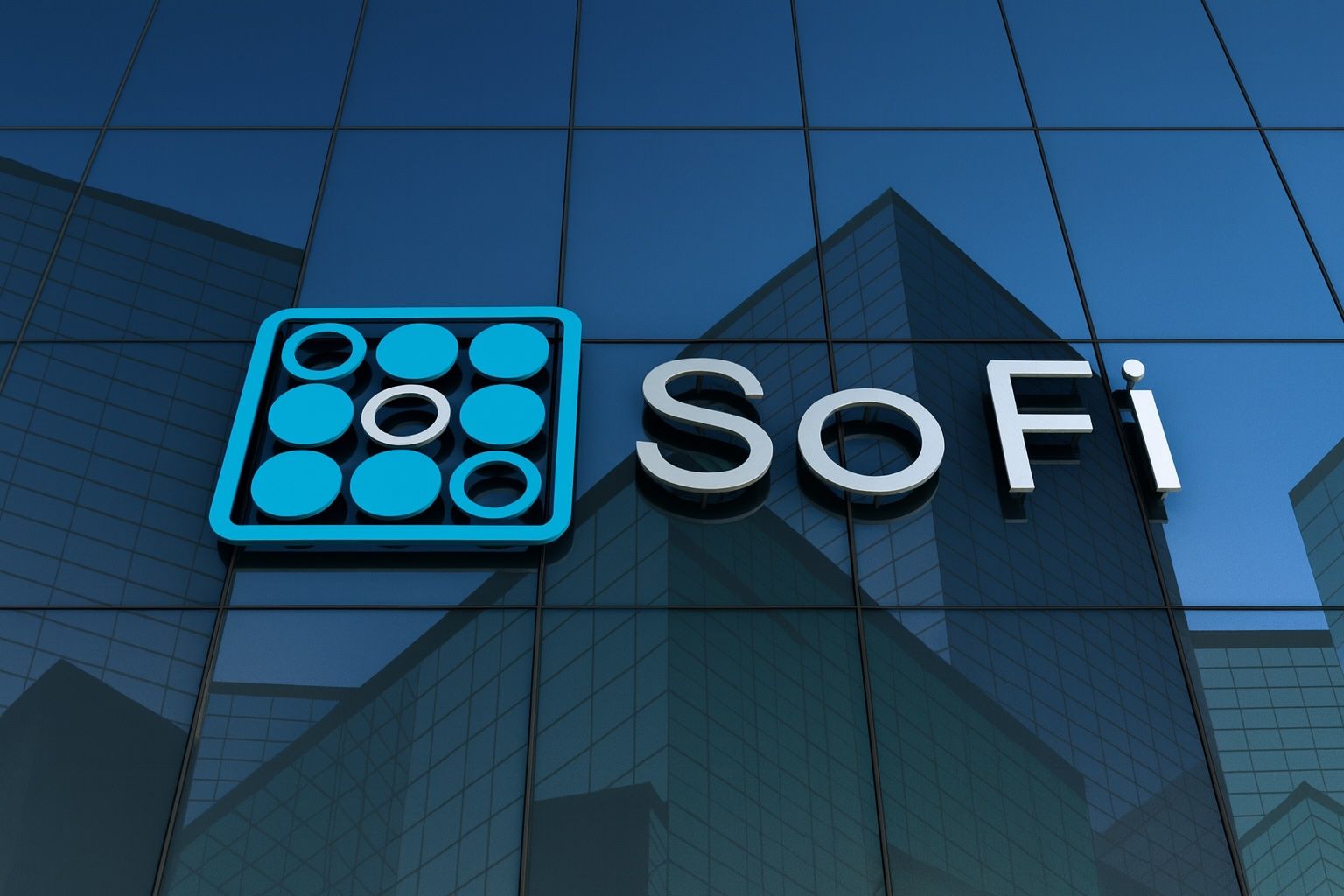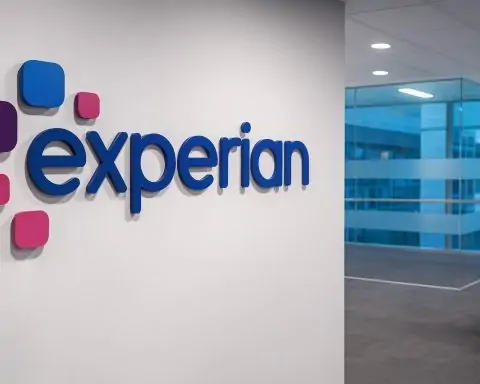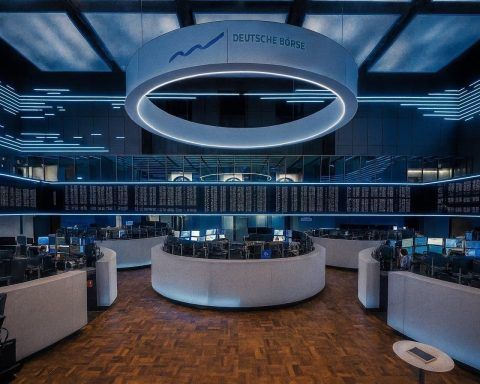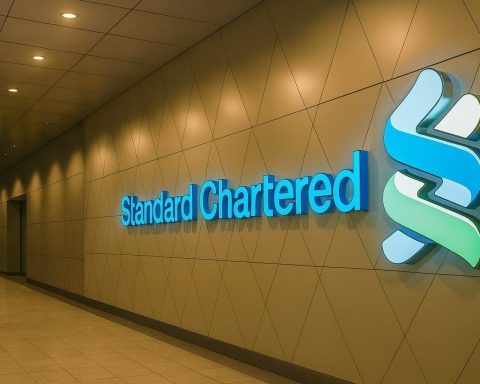- Stock price and trading activity: On 1 Oct 2025 SoFi’s stock closed at $25.76 with a –2.5 % daily decline, continuing a multi‑day slide [1]. Shares traded heavily — about 80.7 million — with intraday highs of $27.33 and lows of $25.64, and the 52‑week range stretched from $7.57 to $30.30 [2]. The company’s market cap hovered near $30.85 billion, and its trailing price‑to‑earnings (P/E) ratio was ≈52.63 [3] [4].
- Financial health: StockAnalysis reports revenue of ≈$3.03 billion in the last twelve months and net income of $561.6 million with earnings‑per‑share (EPS) of $0.49 [5]. The company maintains a current ratio of 1.16 and debt‑to‑equity ratio of 0.60 [6]. Shares outstanding were about 1.20 billion, and institutional investors controlled ≈52.8 % of the float [7].
- Valuation metrics: Trailing P/E of 52.63 and forward P/E of 60.63 highlight a premium valuation relative to many peers [8]. Other valuation ratios include price‑to‑sales (P/S) of 9.52, price‑to‑book (P/B) of 4.47, and PEG ratio of 2.35 [9]. The stock’s beta of 1.93 signals above‑average volatility [10].
- Recent news: SoFi scheduled its third‑quarter 2025 earnings call for 28 Oct 2025 and reported that it serves 11.7 million members with its Galileo technology platform powering ≈160 million accounts [11]. Analysis from AInvest described a 44 % revenue increase but flagged rising customer acquisition costs (≈$284 per member), $3.94 billion in debt, and regulatory headwinds around student loan forgiveness [12]. Morgan Stanley warned that the stock’s ≈250 % year‑over‑year rally may be “overextended” and could be vulnerable if interest rates decline [13].
- Sector comparison: Competitors show mixed valuations. Buy‑now‑pay‑later firm Affirm (AFRM) traded at ≈$74.42 with a P/E of 486.32 and market cap $24.23 billion, while LendingClub (LC), a deposit and consumer‑loan lender, traded near $14.93 with a P/E of 23.28 [14] [15]. Trading platform Robinhood (HOOD) commanded a market cap of $123.65 billion, P/E around 70.81, and price of $139.14 [16].
- Outlook: Analysts offered price targets ranging from ≈$14 to $38 per share; Seaport Research raised its FY2025 EPS estimate to $0.31, while other experts highlighted profitability challenges amid high interest rates and regulation [17].
Overview of SoFi Technologies
SoFi Technologies, Inc., founded as a student‑loan refinancing startup, has evolved into a digital “one‑stop shop” for financial services. A news release on 1 Oct 2025 noted that the company provides products that help members borrow, save, spend, invest and protect their money, while its Galileo and Technisys platforms supply banking technology to other institutions, together processing roughly 160 million accounts [18]. Membership has grown rapidly to about 11.7 million members, demonstrating SoFi’s reach across personal loans, student loans, mortgages, credit cards, brokerage, cash management and workplace‑benefits channels [19].
The company’s mission is to achieve profitability through cross‑selling and operating leverage. To that end, SoFi positions its mobile app as a “financial superapp” that offers everyday banking alongside high‑margin lending and investment products. The firm funds loans via deposits from its chartered bank subsidiary and securitization markets, while generating fees from technology services and SoFi Invest trades. Success will depend on balancing growth with profitability, especially as marketing costs rise and regulatory scrutiny intensifies [20].
Current Stock Price and Financial Indicators
The investor‑relations site shows that on 1 Oct 2025 SoFi shares closed at $25.76, down $0.66 (-2.50 %) from the prior session with approximately 80.68 million shares traded; the stock opened at $26.73, reached an intraday high of $27.33, low of $25.64, and finished near the mid‑range [21]. The 52‑week range extended from $7.57 to $30.30, illustrating the magnitude of SoFi’s rally after bottoming earlier in the year [22]. A banner on the site summarized the quote as “NASDAQ: SOFI 25.76 –0.66 (–2.50 %) Vol: 80,680,050” and noted that the data was delayed by 20 minutes [23].
StockAnalysis values SoFi at ≈$30.85 billion (market cap) and $32.91 billion (enterprise value) [24]. The trailing P/E ratio of 52.63 and forward P/E of 60.63 mean investors are paying a premium for future growth [25]. Additional valuation metrics include a price‑to‑sales ratio of 9.52, price‑to‑book ratio of 4.47, and PEG ratio of 2.35 [26]. SoFi exhibits elevated volatility with a beta of 1.93 and a 52‑week price change of roughly +227 %, although its share price sits below the 52‑week high [27].
Operationally, the company generated ≈$3.03 billion in revenue over the last twelve months and net income of $561.6 million; earnings‑per‑share were $0.49 [28]. SoFi’s liquidity appears adequate with a current ratio of 1.16 and quick ratio of 0.48 [29]. The debt‑to‑equity ratio of 0.60 suggests moderate leverage [30], while return on equity of 8.80 % and return on assets of 1.52 % indicate the company is generating modest returns relative to its capital base [31]. Investors should also note the large share count (≈1.20 billion shares outstanding) and institutional ownership around 52.84 % [32].
Trading Momentum and P/E Context
During early October the stock experienced heightened volatility. Benzinga reported that SoFi traded near $26.72 on 30 Sep 2025 and had risen 6.27 % over the past month and ≈232 % over the prior year, yet its P/E ratio of ≈52.84 still exceeded the consumer‑finance industry average of 47.91 [33]. The article cautioned that a P/E ratio should not be used in isolation when evaluating a company’s valuation [34]. This context suggests investors were pricing in significant growth, leaving the stock vulnerable to disappointment.
Recent News and Developments
Third‑Quarter Earnings Call Announcement
On 1 Oct 2025, SoFi issued a press release scheduling its third‑quarter 2025 results call for Tuesday, 28 Oct 2025 at 8 a.m. ET [35]. The company said it would release earnings at 7 a.m. and host a webcast to discuss financial and operating results. The release reiterated SoFi’s mission to provide a member‑centric financial platform, highlighting its 11.7 million members and the Galileo platform’s ≈160 million accounts across partners [36].
Extended Stock Decline and Market Sentiment
Multiple news outlets noted that SoFi shares had been under pressure. Seeking Alpha reported that the stock fell 2.5 % on 1 Oct 2025 to $25.76, marking the seventh consecutive decline [37]. Analysts attributed the slump to profit‑taking after a major rally and worries that the company might be overvalued. Morgan Stanley echoed these concerns, warning that SoFi’s ≈250 % year‑over‑year rally was overextended and that a drop in interest rates could hurt the company’s deposit‑funding advantage [38].
AInvest Deep‑Dive Analysis
AInvest published a detailed article on 1 Oct 2025 examining why the stock had stumbled. The piece highlighted the 44 % revenue growth over the previous year and the addition of ≈850 000 new members but argued that operating expenses were rising faster than revenue because SoFi spent heavily on marketing. Customer acquisition costs reportedly jumped to about $284 per new member, while total debt stood at $3.943 billion [39]. The article noted that SoFi’s net interest margin improved to 6.01 % and deposits reached $27 billion, yet the company still missed adjusted EBITDA guidance because of margin compression from high interest rates [40].
The article also addressed regulatory risks. SoFi’s student‑loan refinancing business is sensitive to U.S. government policy; uncertainty surrounding the Biden administration’s forgiveness plan and repeated extensions of the student‑loan repayment pause have suppressed refinancing volume [41]. Additionally, high interest rates increased the cost of funding and reduced demand for personal loans. Analysts quoted in the article were split, with price targets ranging from ≈$13.98 to $38, while Seaport Research raised its FY2025 EPS estimate to $0.31 [42]. The report concluded that SoFi’s stock decline reflects a “tug‑of‑war between growth and structural challenges” and that upcoming quarterly results would be pivotal [43].
Expert Commentary and Analyst Forecasts
Investors remain divided on SoFi. The Morgan Stanley note described the stock’s rally as unsustainable and implied that potential Federal Reserve rate cuts could compress net interest margins; because SoFi funds loans primarily through deposits, lower rates would reduce the spread it earns on lending [44]. On the other hand, some analysts view SoFi as a long‑term winner in digital banking. The company continues to diversify across lending, deposit accounts and fee‑based services, and the Galileo platform provides recurring revenue from fintech partners [45].
Benzinga’s P/E article noted that SoFi’s P/E ratio exceeds the industry average but reminded readers that high growth can justify higher multiples [46]. Seaport Research’s decision to raise its EPS estimate suggests that at least one firm expects earnings momentum to accelerate [47]. Nonetheless, the wide range of price targets underscores uncertainty about profitability. Investors should monitor metrics such as customer acquisition costs, deposit growth and regulatory developments in student‑loan policy.
Competitor Comparison
Affirm (AFRM)
Affirm Holdings is a leader in “buy now, pay later” installment loans. On 1 Oct 2025 its shares traded around $74.42 with a market cap of $24.23 billion, revenue of $3.22 billion and net income of $52.19 million [48]. With 325.65 million shares outstanding and EPS of $0.15, the company’s trailing P/E ratio was an eye‑popping 486.32, though the forward P/E dropped to ≈30.56 [49]. The high P/E reflects expectations for rapid growth but also implies significant risk. Analysts rated the stock a “Buy” with a consensus price target of $80.91, suggesting modest upside [50].
LendingClub (LC)
LendingClub combines a digital bank with marketplace lending. Its stock was priced around $14.93 with a market cap of $1.71 billion, revenue $1.25 billion and net income $74.03 million [51]. With 114.74 million shares and EPS of $0.64, LendingClub’s P/E ratio stood near 23.28, significantly lower than SoFi’s and indicating a more modest valuation [52]. Analysts expected earnings to rise, giving the stock a forward P/E of ≈12.14 and a consensus price target of $16.83 (≈12.7 % upside) [53].
Robinhood (HOOD)
Robinhood Markets, famous for commission‑free stock and crypto trading, is a major fintech rival. Its shares traded around $139.14 with a market cap of $123.65 billion, revenue of $3.57 billion and net income of $1.79 billion [54]. With 888.68 million shares and EPS of $1.96, Robinhood carried a P/E ratio of ≈70.81 (forward P/E about the same) [55]. Analysts rated the stock “Buy,” but the consensus price target of $105.95 actually implied downside, suggesting caution at high valuations [56]. Robinhood’s business model differs materially from SoFi’s; it earns brokerage commissions, interest on cash balances and payment for order flow [57].
Takeaways
Compared with peers, SoFi sits between LendingClub and Robinhood in valuation. SoFi’s P/E of ≈52.63 is elevated but not as extreme as Affirm’s 486 or Robinhood’s 70, while its market cap is smaller than Robinhood’s but larger than LendingClub’s. Investors may perceive SoFi as a growth‑oriented digital bank with broader product offerings than the niche BNPL and marketplace lenders, yet less trading‑driven revenue than Robinhood. The comparison suggests that SoFi’s valuation premium reflects optimism about cross‑selling and technology licensing, but also underscores the importance of achieving profitability.
Broader Fintech and Macro Environment
SoFi operates within a dynamic fintech landscape characterized by rapid innovation, fierce competition and tightening regulation. High interest rates in 2024‑2025 boosted net interest margins but also suppressed demand for personal loans and mortgage refinancings, and they heightened deposit costs. AInvest noted that SoFi’s net interest margin improved to 6.01 % and deposits swelled to $27 billion [58], yet high rates squeezed borrowers and elevated SoFi’s cost of capital. Morgan Stanley warned that if the Federal Reserve cuts rates, SoFi could lose part of its funding advantage [59].
Regulatory uncertainty is another headwind. The Biden administration’s shifting plans for student‑loan forgiveness and repeated extensions of the repayment pause limited demand for refinancing [60]. Proposed rules around BNPL products and increased scrutiny of fintech lending practices could also affect SoFi’s future growth. Conversely, the eventual resumption of student‑loan repayments might provide an opportunity for SoFi to capture refinancing volume.
Fintech competition is intense, with incumbents and startups offering mobile banking, trading, BNPL and payments services. SoFi aims to differentiate by combining banking, lending, investing and financial planning into one app and by licensing its core banking platform (Galileo/Technisys) to other financial institutions [61]. Success will depend on continued innovation, careful risk management and navigating regulatory changes.
Analysis and Outlook
SoFi’s fundamentals show rapid growth with improving profitability, but the stock’s valuation already reflects lofty expectations. Revenue growth of ≈44 %, expanding membership and deposits, and a 6.01 % net interest margin demonstrate momentum [62]. However, soaring marketing spend has pushed customer acquisition costs to $284 per member and total debt to ≈$3.94 billion, raising questions about scalability [63]. Profitability is further challenged by regulatory uncertainty around student‑loan refinancing and the possibility of interest‑rate cuts.
Analyst opinions diverge widely, with price targets from ≈$14 to $38 per share [64]. Investors bullish on SoFi argue that its “financial superapp” and Galileo platform can create a high‑margin ecosystem, unlocking value through cross‑selling and technology licensing. Bears point to the elevated P/E ratio, rising costs, and macro headwinds. The scheduled 28 Oct 2025 earnings call may provide clarity on whether SoFi can sustain growth while controlling costs.
Closing thoughts
SoFi Technologies stands at a crossroads. The stock has delivered outsized returns over the past year but has recently stumbled as investors reassess growth expectations and macroeconomic realities. Key metrics show a company with robust revenue growth, expanding membership and improving net interest margins, yet also significant marketing spend, leverage and regulatory risk [65]. Comparisons with peers reveal that SoFi’s valuation is rich but not as extreme as some fintech competitors. Going forward, the company’s ability to convert its expanding user base into consistent profits — while navigating interest‑rate shifts and student‑loan policy — will determine whether the fintech rocket reignites or continues to cool.
References
1. seekingalpha.com, 2. investors.sofi.com, 3. stockanalysis.com, 4. stockanalysis.com, 5. stockanalysis.com, 6. stockanalysis.com, 7. stockanalysis.com, 8. stockanalysis.com, 9. stockanalysis.com, 10. stockanalysis.com, 11. www.morningstar.com, 12. www.ainvest.com, 13. schwabnetwork.com, 14. stockanalysis.com, 15. stockanalysis.com, 16. stockanalysis.com, 17. www.ainvest.com, 18. www.morningstar.com, 19. www.morningstar.com, 20. www.ainvest.com, 21. investors.sofi.com, 22. investors.sofi.com, 23. investors.sofi.com, 24. stockanalysis.com, 25. stockanalysis.com, 26. stockanalysis.com, 27. stockanalysis.com, 28. stockanalysis.com, 29. stockanalysis.com, 30. stockanalysis.com, 31. stockanalysis.com, 32. stockanalysis.com, 33. www.benzinga.com, 34. www.benzinga.com, 35. www.morningstar.com, 36. www.morningstar.com, 37. seekingalpha.com, 38. schwabnetwork.com, 39. www.ainvest.com, 40. www.ainvest.com, 41. www.ainvest.com, 42. www.ainvest.com, 43. www.ainvest.com, 44. schwabnetwork.com, 45. www.morningstar.com, 46. www.benzinga.com, 47. www.ainvest.com, 48. stockanalysis.com, 49. stockanalysis.com, 50. stockanalysis.com, 51. stockanalysis.com, 52. stockanalysis.com, 53. stockanalysis.com, 54. stockanalysis.com, 55. stockanalysis.com, 56. stockanalysis.com, 57. stockanalysis.com, 58. www.ainvest.com, 59. schwabnetwork.com, 60. www.ainvest.com, 61. www.morningstar.com, 62. www.ainvest.com, 63. www.ainvest.com, 64. www.ainvest.com, 65. www.ainvest.com










